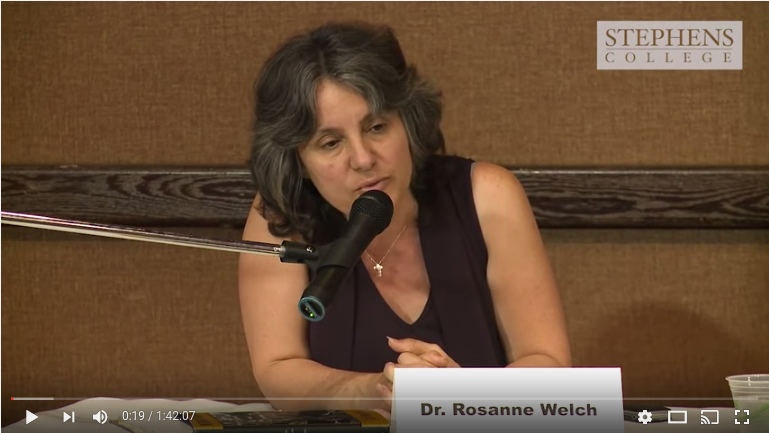You Can Please Some of the People Some of the Time… None of the People All of the Time: A History of the Art of Adaptation in Movies like Dune, The Godfather, Harry Potter and More!
Dr. Rosanne Welch speaks on A History of the Art of Adaptation in Movies like Dune, The Godfather, Harry Potter and More! at the California State University, Fullerton Library
Part of the program series for Dune by Frank Herbert: A 50th Anniversary Celebration.
Watch this entire presentation
Transcript:
But more importantly, change wise, we have George Peppard — who some of you will remember in childhood as part of the A-Team — but he’s a huge movie star in this period. He’s a leading man and he’s a write in this piece. He rally stands in for Truman Capote. This is really a story about Truman Capote’s first time in New York getting his first novel sold. So, George Peppard in the movies, this is a love story and they fall in lovd with each other in the end even though she’s a free spirit. She’s never going to fall in love with anybody. She doesn’t want to be tied down by a man. Becomes a lovely romance. By the time we’re done, the cat is a symbol of how she won’t commit, because she never names her cata and at the very end of the movie — to prove she doesn’t need anybody — she dumps the cat out of a taxi int eh rain and it goes sauntering off and gets all soaking wet and the proof that she’s changed and grown is that she jumps out of the taxi and chases down the cat and she saves it. Then she names that cat and we’re like “Ok. She’s grown. She’s changed. What a beautiful love story.” There’s a small problem with that adaptation. even Truman Capote himself said “The only thing they took from my book was the title.”
About this talk
Dr. Rosanne Welch (RTVF) speaks on the craft of history of film adaptations from the controversy of the silent film Birth of a Nation (protested by the National Association for the Advancement of Colored People in 1915) to Breakfast at Tiffany’s (to which author Truman Capote famously said, “The only thing left from the book is the title”) to The Godfather . Naturally, the behemoth in adaptation – Harry Potter (which depended on the relationship created by adapter Steve Kloves and author J.K. Rowling) will be discussed, as will the subject of this month’s celebration: Dune.
Date: Wednesday, October 14, 2015 Time: 1:00pm – 2:00pm
About Dr. Rosanne Welch
Dr. Rosanne Welch is a professor in the Low Residency MFA in Screenwriting Program from Stephens College, California State University, Fullerton, Mount San Antonio Community College and Cal Poly Pomona. In 2007, she graduated with her Ph.D. in 20th Century U.S./Film History from Claremont Graduate University. She graduated with her M.A. in 20th Century United States History from California State University, Northridge in 2004.
Welch is also a television writer/producer with credits for Beverly Hills 90210 , CBS’s Emmy winning Picket Fences and Touched By An Angel . She also writes and hosts her own podcasts on 3rdPass.media, her first one titled “Mindful(I) Media with Dr. Rosanne Welch.”
Her upcoming book, “Why The Monkees Matter: Teenagers, Television and American Pop Culture” will be published in Fall 2016
Three Ring Circus: How Real Couples Balance Marriage, Work and Kids and The Encyclopedia of Women in Aviation and Space are two books she has written. Los Angeles Times and the Journal of Screenwriting hold some of her published articles.
Dr. Rosanne Welch Web Site and Blog
Podcast: Play in new window | Download
Subscribe: RSS
![More on Breakfast at Tiffany’s from A History of the Art of Adaptation [Video] (1:03)](https://rosannewelch.com/wp-content/uploads/2016/07/adapt-11-breakfast-2.jpeg)
![How to Succeed as a Female Writer in TV & Film by Rosanne Welch | Writers Digest Online [Article]](https://rosannewelch.com/wp-content/uploads/2016/07/howto2-300.jpg)
![Breakfast at Tiffany’s from A History of the Art of Adaptation [Video] (0:53)](https://rosannewelch.com/wp-content/uploads/2016/07/adapt-10-breakfast.jpeg)


![Hays Code Prohibitions in Film from A History of the Art of Adaptation [Video] (0:51)](https://rosannewelch.com/wp-content/uploads/2016/06/adapt-09-hays-code-2.jpeg)
![Writer, Ken LaZebnik, talks “Hollywood Digs” on This American Wife Podcast [Audio]](https://rosannewelch.com/wp-content/uploads/2016/06/this-american-wife.jpg)
![Panel: Increasing the Power of Women’s Voices in Hollywood from the Stephens College MFA in Screenwriting Program [Video]](https://rosannewelch.com/wp-content/uploads/2016/06/women-in-the-room-panel.png)
![Adaptation, Decency and the Hays Code from A History of the Art of Adaptation [Video] (0:56)](https://rosannewelch.com/wp-content/uploads/2016/06/adapt-08-hays-code.jpeg)
![How “The Clansman” Affected Racist Culture from A History of the Art of Adaptation [Video] (2:02)](https://rosannewelch.com/wp-content/uploads/2016/06/adapt-07-clansman-culture.jpeg)
![Adapting “The Clansman” from A History of the Art of Adaptation [Video] (1:05)](https://rosannewelch.com/wp-content/uploads/2016/06/adapt-06-clansman.jpeg)